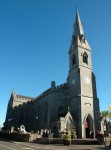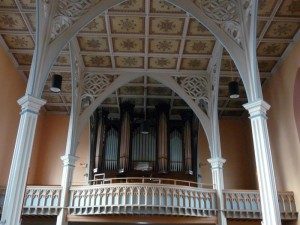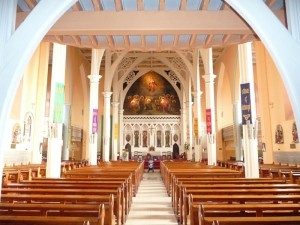
| Monday - Friday | 7.40am, 11.00am, 7.30pm |
| Saturday | 11.00am, 6.30pm |
| Sunday | 8:00am, 9:30am, 11:30am |
| Church Holidays |
See current newsletter Mass is also celebrated in the Poor Clare’s Monastery at 7.45am daily. Worship time for the Church of Ireland in Ennis is on Sunday mornings at 11.30am in St. Columba's Church, Bindon Street, Ennis |
The Building & Its People
Ennis Cathedral: The Building & Its People. A Presentation by the Clare Roots society is available for download (pdf, 1mb)
The site for the cathedral was donated by Francis Gore, a Protestant landowner in 1828. The building was originally intended to serve as the parish church of Ennis.
The architect was Dominick Madden who had also designed the cathedrals in Ballina & Tuam.
Financial pressure hindered the project which resulted in a suspension of work for three years. It was not until 1842 that the roof was put on the building and the first Mass was held in the still unfinished building by parish priest, Dean O’Shaughnessy.
On 26 February 1843 the new church was blessed and placed under the patronage of SS Peter and Paul by Bishop Patrick Kennedy. Work recommenced after the Great Famine, with emphasis placed on the interior design. J.J. McCarthy was commissioned to oversee the project, some of which is still visible today – the internal pillars & arches and the organ gallery
In 1874 the tower and spire were completed and in 1890 Dr Thomas McRedmond was consecrated as the Bishop of Killaloe. The parish church of SS Peter & Paul was designated as the pro-cathedral of the diocese when the new Bishop decided to make Ennis his home.
Major renovations were carried out in 1894 – the construction of the present main entrance and the redecoration of the building. The large painting of the Ascension which dominates the sanctuary (the work of Nagle & Potts) was also installed at this time. A new sacristy and chapter room were added in the 1930s as were the pipe organ and chapter stalls for the canons.
In 1973, work was carried out to bring the building into line with the requirements of the Second Vatican Council. The team involved in the renovation included architect-Andrew Devan; contractors-The Ryan Brothers and artistic advisor-Enda King. The building was reopened after six months in December 1973.
In 1990, 163 years after work on the building began, Bishop Harty named it a cathedral. The solemn dedication of the cathedral and the altar took place on 18 November 1990. The sanctuary was rebuilt and the building redecorated after a fire at a shrine in the cathedral in October 1995. The restoration was celebrated with Solemn Evening Prayer in November 1996.
The Organ
This fine organ was built in 1930 by a Belfast and Dublin company called Evans and Barr and cost £3,345.00. A company called Meaths from Mullingar now repair, tune, and maintain the organ. There were many generous contributions to the organ, including that of Most Rev. Michael Fogarty who gave £1,000.00 to the fund.

In 1985, the organ was refurbished. A standing order with Meaths Organists, Dublin was placed, to the effect that for the next ten years they would tune and repair the organ. The total cost of this was £30,000.
List of Organists & Choirmasters since 1930:
Organists:
John Jones, Pat Flynn, Ita O’Shea, Nell Hanley, Harry Hitching, Cormac McGuinness, Nigel Bridge, Ita O’Shea, Nell Hanley, Cormac McGuinness, Sr. Elizabeth O’Malley,Mary Curley, Michael Hennessy & Leon Walsh.
Choirmaster and Organist:
Ernest de Regge, Fr. Patrick O’Brien, Fr. Kieran O’Gorman, Sr. Elizabeth O’Malley, Carmel Griffin, Mary Curley, Michael Hennessy & Leon Walsh.
Its History:
The organ comprises three manual departments and a pedal organ playable from a three-manual electric action console situated about ten feet from the front of the organ case. It contains 2,152 pipes spread over 35 stops or 38 ranks. The three manuals, each full size C to c’’’ (five octaves), are Great, Swell and Choir. The pedal board is full-size C to g’ (two and a half octaves). The organ contains 28 flue stops and 7 reeds. There are many console accessories as well as two tremulants. The organ has a large Swell department.
